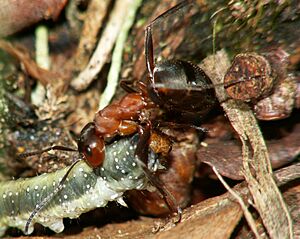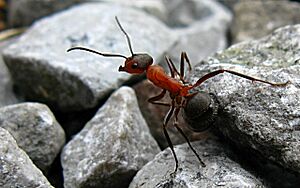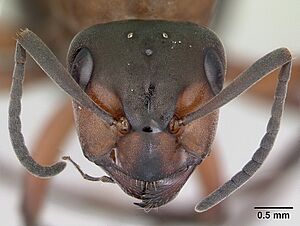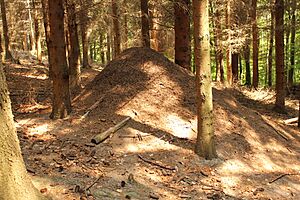Red wood ant facts for kids
Quick facts for kids Red wood ant |
|
|---|---|
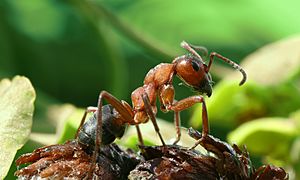 |
|
| Formica rufa worker | |
| Conservation status | |
| Scientific classification | |
| Genus: |
Formica
|
| Species: |
rufa
|
The Formica rufa, also known as the red wood ant or southern wood ant, is a type of ant found in cool, northern parts of the world. It lives across Europe and Asia, from Scandinavia to Spain, and from Great Britain all the way to Lake Baikal in Russia.
These ants have red heads and chests, and their bodies are brownish-black. They often have darker spots on their heads. Red wood ants can be 4.5 to 9 millimeters long. They have strong jaws and can spray a special liquid called formic acid from their bodies to defend themselves. This acid was first discovered in 1671 by an English scientist named John Ray, who got it from these ants!
Adult red wood ants mostly eat a sweet liquid called honeydew, which comes from tiny insects called aphids. Some groups of these ants have many queens and connect their nests together. Other groups have only one queen in each nest.
Contents
About Red Wood Ants
Red wood ants build very large, easy-to-spot nests. These nests look like big domes made of grass, twigs, or pine needles. They are often built next to old tree stumps in sunny spots in woodlands.
A large red wood ant colony can have anywhere from 100,000 to 400,000 worker ants and even 100 queens! Some of these nests can grow to be several meters tall and wide. Red wood ants are very protective of their homes and will often fight off other ant species.
In the springtime, young male and female ants fly out to mate. This time can be busy with fights between different ant colonies as they decide where their territories are. New nests can start when a group of ants and a queen move from an old nest. Sometimes, a red wood ant queen will even take over another ant species' nest, laying her eggs there until her own offspring grow up and take over the nest completely.
What Red Wood Ants Eat
While their main food is honeydew from aphids, red wood ants also hunt and eat other small creatures like insects and spiders. They are also good at finding and eating dead animals. They can travel up to 100 meters from their nest to find food. Larger worker ants tend to go farther away to search. Because they eat many insects, red wood ants are sometimes used in forests to help control pests.
Ant Behavior
Caring for Young
Worker ants in a red wood ant colony are very good at taking care of the young ants, which are in cocoons. A worker ant learns to recognize its own colony's cocoons by a special smell. If a worker ant grows up without any cocoons around, it won't know how to care for them and might even eat them for food.
However, if a worker ant learns to care for its own colony's cocoons, it will collect and protect them. If it finds cocoons from a different ant species, it might collect them but then leave them alone or eat them. This shows that a chemical smell from the cocoons is very important for the worker ants to know which young to care for.
Finding Food
How red wood ants look for food changes depending on where they are. They are known to "farm" aphids for their honeydew and also hunt other insects. They usually hunt for the most common insects in their area, whether those insects are in tree branches or on the forest floor.
Red wood ants prefer to find food in trees close to their nest. But if food becomes scarce, they will travel to trees farther away and explore more trees instead of searching the ground more carefully. This makes finding food less efficient, but the rest of the colony doesn't usually help the ants that are searching.
Colony Relationships
Red wood ants can sometimes be aggressive towards other red wood ants from different colonies. This usually happens in the spring when workers from different nests fight to protect their territory and foraging paths. These territories can change with the seasons. If an ant from a different colony crosses a path that is used regularly, fights can break out.
Ants recognize their nestmates by special chemical smells. If they can't recognize their own, the colony can have problems. Sometimes, pollution in the environment, like heavy metals, can change how aggressive ants are. This might be because it affects their bodies or how much food they have. Ants in polluted areas tend to be less efficient.
Colony Life
Nest Structure
Different types of red wood ants can have different social structures. Some groups have many queens and connect many nests together to form large networks. Others have only one queen in each nest. It seems that red wood ants from different places can be either single-queen or multi-queen colonies.
In single-queen nests, new queens fly off to start their own nests. In multi-queen nests, new queens often start new nests close to the original one, with help from the worker ants. Over time, colonies with one queen might even start to accept more queens, becoming multi-queen colonies.
Moving Nests
Red wood ants often have several nests. This allows them to move if something big changes in their environment. For example, they might move if there isn't enough food, if another ant colony attacks them, or if their old nest gets damaged. When they move, workers, queens, and young ants (brood) are carried back and forth between the old and new nests. This moving process can take anywhere from a week to over a month.
Colony Lifespan
Red wood ant nests can change quickly. One study found 248 nests in a large area over three years. It also showed that smaller nests usually don't last as long as larger ones. As nests get older, they tend to grow bigger.
Bee Paralysis Virus
In 2008, a virus called the chronic bee paralysis virus was found in red wood ants for the first time. This virus can affect bees, ants, and mites.



